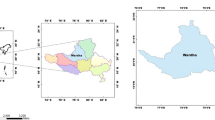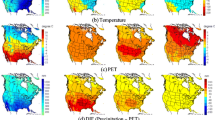Abstract
A comparison study of meteorological, hydrological and agricultural drought responses to climate change resulting from different General Circulation Models (GCMs), emission scenarios and hydrological models is presented. Drought variations from 1961–2000 to 2061–2100 in Huai River basin above Bengbu station in China are investigated. Meteorological drought is recognized by the Standardized Precipitation Index (SPI) while hydrological drought and agricultural drought are indexed with a similar standardized procedure by the Standardized Runoff Index (SRI) and Standardized Soil Water Index (SSWI). The results generally approve that hydrological and agricultural drought could still pose greater threats to local water resources management in the future, even with a more steady background to meteorological drought. However, the various drought responses to climate change indicate that uncertainty arises in the propagation of drought from meteorological to hydrological and agricultural systems with respect to alternative climates. The uncertainty in hydrological model structure, as well as the uncertainties in GCM and emission scenario, are aggregated to the results and lead to much wider variations in hydrological and agricultural drought characteristics. Our results also reveal that the selection of hydrological models can induce fundamental differences in drought simulations, and the role of hydrological model uncertainty may become dominating among the three uncertainty sources while recognizing frequency of extreme drought and maximum drought duration.





Similar content being viewed by others
References
Bastola S, Murphy C, Sweeney J (2011) The role of hydrological modelling uncertainties in climate change impact assessments of Irish river catchments. Adv Water Resour 34(5):562–576
Blenkinsop S, Fowler HJ (2007) Changes in drought frequency, severity and duration for the British isles projected by the PRUDENCE regional climate models. J Hydrol 342:50–71
Burke EJ, Brown SJ (2008) Evaluating uncertainties in the projection of future drought. J Hydrometeorol 9(2):292–299
Chen J, Brissette FP, Leconte R (2011) Uncertainty of downscaling method in quantifying the impact of climate change on hydrology. J Hydrol 401(3):190–202
Chiew FHS, Peel MC, Western AW (2002) Application and testing of the simple rainfall–runoff model SIMHYD. In: Singh VP, Frevert DK (eds) Mathematical models of small watershed hydrology and applications. Water Resources Publications, Littleton, Colorado
Crosbie RS, Scanlon BR, Mpelasoka FS, Reedy RC, Gates JB, Zhang L (2013) Potential climate change effects on groundwater recharge in the high plains aquifer, USA. Water Resour Res 49(7):3936–3951
Dai A, Trenberth KE, Qian T (2004) A global data set of palmer drought severity index for 1870–2002: relationship with soil moisture and effects of surface warming. J Hydrometeorol 5:1117–1130
Duan K, Mei Y (2014) A comparison study of three statistical downscaling methods and their model-averaging ensemble for precipitation downscaling in China. Theor Appl Climatol 116(3-4):707–719
Duan QY, Gupta VK, Sorooshian S (1993) Shuffled complex evolution approach for effective and efficient global minimization. J Optim Theory Appl 76(3):501–521
Duan K, Xiao W, Mei Y, Liu D (2014) Multi-scale analysis of meteorological drought risks based on a Bayesian interpolation approach in Huai River basin, China. Stoch Env Res Risk A. doi:10.1007/s00477-014-0877-4
Hao Z, AghaKouchak A (2013) Multivariate standardized drought index: a parametric multi-index model. Adv Water Resour 57:12–18
Hashmi MZ, Shamseldin AY, Melville BW (2011) Comparison of SDSM and LARS-WG for simulation and downscaling of extreme precipitation events in a watershed. Stoch Env Res Risk A 25(4):475–484
Hulme M, Marsh R, Jones PD (1992) Global changes in a humidity index between 1931–90 and 1961–90. Clim Res 2(1):1–22
Jung IW, Moradkhani H, Chang H (2012) Uncertainty assessment of climate change impacts for hydrologically distinct river basins. J Hydrol 466:73–87
Kirono DGC, Kent DM, Hennessy KJ, Mpelasoka F (2011) Characteristics of Australian droughts under enhanced greenhouse conditions: results from 14 global climate models. J Arid Environ 75(6):566–575
Liu L, Hong Y, Bednarczyk CN et al (2012) Hydro-climatological drought analyses and projections using meteorological and hydrological drought indices: a case study in Blue River Basin, Oklahoma. Water Resour Manag 26(10):2761–2779
Ma Z, Fu C (2007) The global drying fact in latter half century of 20th and its relationship with large-scale background. Sci China Ser D 37(2):222–233
Massey FJ (1951) The kolmogorov-smirnov test for goodness of Fit. J Am Stat Assoc 46(253):68–78
Maurer EP (2007) Uncertainty in hydrologic impacts of climate change in the Sierra Nevada, California, under two emissions scenarios. Clim Chang 82(3-4):309–325
McKee TB, Doesken NJ, Kliest J (1993) The relationship of drought frequency and duration to time scales. In: Proceedings of the 8th conference on applied climatology 17–22 January, Anaheim, CA. American Meteorological Society, Boston, pp 179–184
Mishra AK, Desai VR (2005) Drought forecasting using stochastic models. Stoch Env Res Risk A 19:326–339
Mishra AK, Singh VP (2010) A review of drought concepts. J Hydrol 391:202–216
Mpelasoka F, Hennessy K, Jones R et al (2008) Comparison of suitable drought indices for climate change impacts assessment over Australia towards resource management. Int J Climatol 28:1283–1292
Nalbantis I, Tsakiris G (2009) Assessment of hydrological drought revisited. Water Resour Manag 23:881–897
Ryu JH, Sohrabi M, Acharya A (2014) Toward mapping gridded drought indices to evaluate local drought in a rapidly changing global environment. Water Resour Manag 28(11):3859–3869
Seibert J (1997) Estimation of parameter uncertainty in the HBV model. Nord Hydrol 28(4/5):247–262
Semenov MA, Stratonovitch P (2010) Use of multi-model ensembles from global climate models for assessment of climate change impacts. Clim Res 41:1–14
Semenov MA, Brooks RJ, Barrow EM, Richardson CW (1998) Comparison of the WGEN and LARS-WG stochastic weather generators for diverse climates. Clim Res 10:95–107
Sheffield J, Goteti G, Wen F, Wood EF (2004) A simulated soil moisture based drought analysis for the United States. J Geophys Res. doi:10.1029/2004JD005182
Shukla S, Wood AW (2008) Use of a standardized runoff index for characterizing hydrologic drought. Geophys Res Lett. doi:10.1029/2007GL032487
Sylla MB, Gaye AT, Jenkins GS et al (2010) Consistency of projected drought over the Sahel with changes in the monsoon circulation and extremes in a regional climate model projections. J Geophys Res. doi:10.1029/2009JD012983
Tian Y, Xu YP, Zhang XJ (2013) Assessment of climate change impacts on river high flows through comparative use of GR4J, HBV and Xinanjiang models. Water Resour Manag 27(8):2871–2888
Vicente-Serrano SM, Beguería S, López-Moreno JI (2010) A multiscalar drought index sensitive to global warming: the standardized precipitation evapotranspiration index. J Clim 23(7):1696–1718
Wang D, Hejazi M, Cai X, Valocchi AJ (2011) Climate change impact on meteorological, agricultural, and hydrological drought in central Illinois. Water Resour Res. doi:10.1029/2010WR009845
Wilhite DA, Glantz MH (1985) Understanding the drought phenomenon: the role of definitions. Water Int 10:111–120
Zargar A, Sadiq R, Khan FI (2014) Uncertainty-driven characterization of climate change effects on drought frequency using enhanced SPI. Water Resour Manag 28(1):15–40
Zhang L, Potter N, Hickel K, Zhang Y, Shao Q (2008) Water balance modeling over variable time scales based on the Budyko framework – Model development and testing. J Hydrol 360:117–131
Zhao RJ (1992) The Xinanjiang model applied in China. J Hydrol 135:371–381
Acknowledgements
This work is supported by the Major Program of National Natural Science Foundation of China (51239004). The authors are grateful to Prof. Lihua Xiong in Wuhan University and two anonymous reviewers for their valuable comments that substantially improved the manuscript.
Author information
Authors and Affiliations
Corresponding author
Rights and permissions
About this article
Cite this article
Duan, K., Mei, Y. Comparison of Meteorological, Hydrological and Agricultural Drought Responses to Climate Change and Uncertainty Assessment. Water Resour Manage 28, 5039–5054 (2014). https://doi.org/10.1007/s11269-014-0789-6
Received:
Accepted:
Published:
Issue Date:
DOI: https://doi.org/10.1007/s11269-014-0789-6




